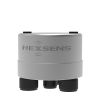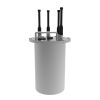Airmar EchoRange SS510 Smart Sonar Depth Sensor
Features
- Embedded transceiver with digital signal processing
- Outputs depth & temperature using NMEA 0183 data output
- Robust 316 stainless steel housing for fixed or portable mounting
- Free ground shipping
- Expedited repair and warranty service
- Lifetime technical support
- More
Overview
Pairing the Airmar EchoRange SS510 Smart Sensor with a computer or data logger provides a low-cost, portable hydrographic survey system. The EchoRange can also be fixed to a bridge abutment or pillar for unattended monitoring of scouring conditions.
Data Collection
The sensor digitally processes depth and water temperature signals to communicate data via NMEA 0183 protocol. Using NMEA 0183, the sensor easily interfaces with computers or data collection platforms with a data output rate of up to 10 times per second. The EchoRange is constructed with a robust stainless steel housing and has a measurement range from 0.4m to 200m with 0.01m resolution.
- Depth Reading Range: 0.4m to 200m
- Depth Resolution: 0.01m
- Depth Precision: 0.25% at full range
- Frequency: 200 kHz
- Beam Angle: 9°
- Temperature Sensor Accuracy: +/-0.05° C
- Temperature Resolution: 0.09° C
- Supply Voltage: 9 VDC to 40 VDC
- Average Current Draw: 150mA @ 13.6V
- Power & Data Cable: C304, 4 twisted shielded pairs, 20m
- NMEA0183 Baud Rate: 4,800
- Airmar EchoRange SS510 Smart Sonar Depth Sensor Specifications
- Airmar EchoRange SS510 Smart Sonar Depth Sensor Manual
- Airmar EchoRange SS510 Smart Sonar Depth Sensor Installation Guide
- Airmar EchoRange SS510 Smart Sonar Depth Sensor Support Drawings
- Airmar EchoRange SS510 Smart Sonar Depth Sensor Wiring Diagram
- Guide to Monitoring Scour at Bridges and Offshore Structures
In The News
From Paddles to Phytoplankton: Studying Vermont’s Wildest Lakes
For six months of the year, Rachel Cray, a third-year PhD student at the Vermont Limnology Laboratory at the University of Vermont, lives between a microscope and her laptop, running data. For the other six months, she is hiking and canoeing four of Vermont’s lakes, collecting bi-weekly water samples. Cray studies algal phenology across four lakes in Vermont, US, that have low anthropogenic stress—or in other words, are very remote. Funded by the National Science Foundation Career Award to Dr. Mindy Morales, the lakes Cray researches part of the Vermont Sentinel Lakes Program, which studies 13 lakes in the area and, in turn, feeds into the Regional Monitoring Network, which operates in the Northeast and Midwest US.
Read MoreReimagining Water Filtration: How Monitoring and Science Enhance FloWater Filtration Systems
Over 50% of Americans think their tap water is unsafe , according to the Environmental Working Group (EWG). Other recent surveys have found that number to be as high as 70% of persons surveyed. Whether due to increased public awareness of water quality issues or confusion about how municipal water sources are regulated, there is a clear distrust of tap water in the United States. According to industry expert Rich Razgaitis, CEO and co-founder of the water purification company FloWater, this issue creates a damaging cycle. Razgaitis explained that the health and environmental problems associated with contaminated water aren’t the only issues. As people become increasingly aware that some tap water is unsafe, they resort to bottled water.
Read MoreMonitoring New Hampshire’s Aquatic Ecosystems: Continuous Data Collection in the Lamprey River Watershed
New Hampshire’s aquatic ecosystems provide a range of ecosystem services to the state and region. Resources and services like clean water, carbon storage, climate regulation, nutrient regulation, and opportunities for recreation all depend on New Hampshire’s aquatic ecosystems remaining healthy. Jody Potter, an analytical instrumentation scientist at the University of New Hampshire (UNH), is studying these aquatic ecosystems in hopes of developing an improved understanding of ecosystem services and their interactions with climate change, climate variability, and land use changes. [caption id="attachment_39799" align="alignnone" width="940"] Aquatic sensors in the Merrimack River in Bedford, NH, with I-293 in the background.
Read More

















